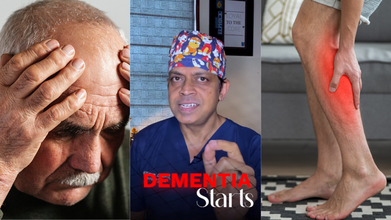- Health Conditions A-Z
- Health & Wellness
- Nutrition
- Fitness
- Health News
- Ayurveda
- Videos
- Medicine A-Z
- Parenting
- Web Stories
Why Your Chronic Pain Might Be The Real Reason For Your Worsening Anxiety And Mood Swings

Image Credit: Canva
Pain is the body’s way of signaling that something is wrong. In most cases, pain fades once the underlying issue heals. However, for millions of people, pain becomes a constant companion, lasting for months or even years. This condition, known as chronic pain, not only affects physical health but also has a profound impact on emotional well-being.
Current studies emphasize the strong link between chronic pain and mental illness such as anxiety and depression. Individuals suffering from long-term pain tend to be stuck in a vicious cycle of fear, stress, and emotional distress. But how does chronic pain actually lead to deteriorating mental health, and how can the cycle be stopped?
For over 45 million Americans, chronic pain is a way of life. Although physical pain is the most visible symptom, its impact reaches far beyond the physical body. Chronic pain is frequently accompanied by psychological distress, as many victims experience anxiety and depression caused by their illness.
As per Dr. Ravi Kesari, a general medicine specialist, "Chronic pain and mental illness tend to exacerbate each other. Patients have disturbed sleep patterns, increased mental tension, and depression-like symptoms. This forms a vicious circle in which pain causes emotional distress, which further increases the perception of pain."
This cycle is especially seen in conditions like:
Fibromyalgia – A syndrome of widespread pain, fatigue, and cognitive difficulty.
Irritable Bowel Syndrome (IBS) – A bowel condition frequently associated with stress and tension.
Lower Back Pain – Prolonged pain in the lower back, often accompanied by decreased mobility and depression.
Migraine and Nerve Pain – Prolonged headaches and nerve pain that interfere with daily functioning.
Research indicates that two-thirds of IBS sufferers experience anxiety symptoms, and 65% of patients with depression exhibit chronic pain symptoms. This commonality indicates that mental illness not only heightens sensitivity to pain but also complicates recovery.
How Stress of Chronic Pain Can Rewires Your Brain?
When a person hurts, the body releases stress chemicals such as cortisol and adrenaline to assist in the regulation of pain. Such hormones are helpful during short-term occurrences, but once pain persists over time, continued exposure to stress hormones alters brain chemistry.
"Chronic pain leads to chronic stress, and that changes the neurochemicals in the brain that control mood, thought processes, and behavior," explains Dr. Kesari. "That's why people with chronic pain tend to be irritable, angry, or drained of emotions."
Chronic exposure to stress hormones can cause:
Heightened anxiety and fear reactions, making people excessively careful about everyday activities.
Depression, as serotonin and dopamine levels decrease—two neurotransmitters that produce happiness and motivation.
Cognitive impairment, including problems concentrating, remembering, or deciding.
Pain, Anxiety, and the Fear of Movement
Another very frequent mental impact of chronic pain is kinesiophobia, or fear of movement. Individuals with chronic pain tend to avoid movement for fear of making their pain worse. This avoidance behavior can cause stiffness in the muscles, loss of mobility, and increased pain over time.
For example, a person with chronic back pain might try to avoid exercising, which would further weaken muscles and worsen their condition. This pattern of avoidance and worsened pain begets a spiraling sense of helplessness that further fuels anxiety and mood shifts.
"Anxiety is an understandable reaction to chronic pain," says Dr. Kesari. "People become concerned about what pain will mean for their lives, so tasks that are minor—such as shopping for groceries or socializing—become overwhelming."
Daily Struggles and Self-Esteem Loss
Chronic pain does not only impact mood; it is able to significantly modify the way an individual perceives himself. Most of those who have chronic pain struggle with simple activities such as exiting bed, dressing up, or personal hygiene. Failing to do so by oneself may cause the individual to feel inadequate, frustrated, and socially withdrawn.
As Dr. Kesari describes, "Patients tend to feel ill at ease in social situations because they view their condition as a restriction. This adds to low self-esteem and exacerbates mental illness such as depression."
Considering the complex connection between chronic pain and mental well-being, both physical and emotional welfare must be treated.
Dr. Kesari stresses, "Healthcare providers need to take a whole-body approach to treating chronic pain. That involves coupling conventional pain management with mental health care to break the cycle between pain and emotional distress."
Some strategies that have been found to be effective are:
Cognitive Behavioral Therapy (CBT) – A type of psychotherapy that enables people to deal with negative thought processes and respond to pain.
Physical Therapy & Movement-Based Practices – Gentle exercise, like tai chi or yoga, decreases pain and alleviates fear of movement.
Medication Management – Painkillers can be beneficial, but only as part of a combination of holistic therapies to prevent dependency.
Stress-Reduction Techniques – Techniques such as meditation, deep breathing, and mindfulness assist in balancing stress hormones.
Social Support & Therapy Groups – Sharing experiences with others who live with chronic pain has been shown to combat the sense of isolation and offer emotional support.
Chronic pain is not merely a physical condition—it has a powerful impact on mental health, causing anxiety, depression, and extreme lifestyle constraints. But knowledge of the interlinkage of pain and emotional health can encourage proactive measures toward improved general well-being.
Dr Ravi Kesari is MBBS, MD- General Medicine at Apollo Spectra Hospital, Bangalore in India
Why Do I Get Bad Dreams When I Am Sick?

Credits: Canva
What's worse than running nose, continuous sneezing, and a fever? It is the dreams you get when you have finally managed to put yourself to sleep, and those dreams are bad, scary, intense, and negative. Why does this happen?
What Is A Fever Dream?
A dream is basically a series of thoughts, images, sensations that you feel while you are sleeping, and scientists tell us that we have our strongest dreams during the rapid eye movement or the REM of the sleep stage.
Certain factors, including you health could influence your sleep visions and your dreams. A change in body temperature, especially when it is higher than usual could lead to a fever dream, which mostly could be intense, like a nightmare.
As per a 2016 study published in the International Journal of Dream Research, 94 per cent of participants described their fever dreams as negative. Another 2013 study noted that one of the participants had dreams that would move "back and forth between a very difficult circumstance and a very comfortable circumstance." A recent online study in 2020, published in the journal Frontiers Psychology noted that of the 164 participants, 100 of them reported fever dreams. Most of them said that fever dreams were more bizarre, and negatively toned.
While fever dream is known in the medical literature, the scientific studies on the same are limited. Many often describe this as an emotionally intense, troubling, strange, out of character, or a scary dream. The dreams could be the result of less social interactions due to someone being sick.
When Does A Fever Dream Happen?
A fever dream happens when the normal body temperature rises 2 degrees above. The normal body temperature is between 97 and 99 degree F. Anyone can develop a fever, due to the following conditions:
- a viral or bacterial infection
- heat exhaustion
- certain inflammatory conditions such as rheumatoid arthritis
- medicines, such as antibiotics
- an immunization
- a tumor
Why Do You Get Bad Dreams During Fever?
While there is no exact reasoning for it, the 2020 online study notes that the concept behind this is the 'over-heated' brain. High temperature of the body could disrupt the brain's normal cognitive functions. The authors of the 2020 study note, "The basic idea is that the ‘over-heated’ brain is not functioning properly and, therefore, dreams are more bizarre.”
During the REM stage of sleep, the phase where your most vivid dreams unfold, the body already struggles to regulate its internal temperature. When a fever strikes, it disrupts this delicate balance even further, often resulting in intense or disturbing dreams. Fevers can also stir the mind in other unsettling ways, sometimes causing waking hallucinations, irritability, or even brief episodes of confusion.
Dr Mark Rosenblum, who is a sleep psychologist with Hennepin Healthcare, tells CBS News that the reason behind intense dream during sickness is due to REM. He says, "If someone's not getting enough sleep, they get what's called REM rebound on the following nights. And when we have REM rebound, what we'll find is all our dreams tend to be very intense."
Are There Any Symptoms Of Fever Dreams?
As per a 2016 study published in the International Journal of Dream, fever dreams contain some sort of spatial distortion, that include:
- Moving walls
- Creatures with oversized arms and legs
- Metal spheres that move like an organism
- Blackness spreading slowly
- Gigantic insects
Dementia Starts In Your Legs, According To Doctor; What Are The Signs And Tips To Prevent It?

Credits: Instagram and Canva
Bengaluru based neurosurgeon Dr Arun L Naik dropped a video on his Instagram account @doclogues, which has shocked the world, because he says that 'Dementia Starts in Your Legs'.
As of now, most of us knew that it is a general term for a loss of thinking, and is part of normal aging and related to brain diseases that damage the nerve cell. However, Dr Naik notes that as per a 2020 study, it was found that those who walk in a slow speed, especially older adults, were more likely to face the risk of cognitive decline. "Why?" To this, Dr Naik writes that walking is not just a physical task, "it is a full brain workout".
How Is Walking Related To Brain Health? Can Lack Of It Cause Dementia?
Dr Naik writes that there exists a brain-leg connection. "Every step involves coordination between the frontal lobe, cerebellum, spinal cord, and proprioceptive feedback loops."
The second point he notes is of the circulation boost. He writes that leg movement improves blood flow to the brain, and it delivers oxygen, glucose, and clears out toxins.
Then comes gait changes, which the doctor says must be considered as brain warning. It is brain's way to tell that changes in walking style, balance, or pace could proceed to memory symptoms by years.
Lastly, he notes is the neuroplasticity in motion. He says that walking stimulates the brain-derived neurotrophic factor, which strengthens neuron connections. This is why, "weak legs can speed up cognitive decline," he says in his video.
What Study Is The Doctor Quoting When He Says That Dementia Starts From Leg?
The study is a 2020 review, which was published in the Journal of Aging Research. This is where it was seen that older adults, who stay physically active are less likely to develop cognitive decline or dementia. The study analyzed over 1,60,000 people and found that regular exercise reduced the risk of dementia by 28 per cent and Alzheimer's disease by 45 per cent.
With aging, especially from mid-50s, most adults begin to lose 1 to 2 per cent of muscle mass every year, this process is further accelerated by inactivity. This loss then not only affects mobility, but also metabolism and blood circulation, which results in less oxygen reaching to your brain, as the doctor also explained.
This is why the doctor says, "if your legs slow down, your brain may follow".
Can Something Be Done To Prevent Dementia?
The answer is yes. Dr Naik also says, "studies have shown that it is never too late to start. Starting even in your 60s can reduce dementia risk by a mile". So, what is he asking people to start? He is urging people to start some activity, to help their bodies move, and enable the brain to leg coordination.
The doctor also notes some "strategies" to prevent dementia in the caption of his post through movements, which are as followed:
- Walk 30 minutes daily at a brisk pace.
- Add balance exercises like tandem walking and single-leg stands.
- Practice dual-task walking (e.g. walking while talking or solving a simple mental task).
- Include strength training for lower limbs—muscle is cognitive insurance.
- Avoid long periods of sitting—movement every hour keeps memory sharp.
Fact Check: Does Cracking Your Knuckles Every Day Damage Your Joints?

Credits: Canva
If you are someone who cracks your knuckles every day just for that oddly satisfying pop, you are not alone. For many, the sharp sound brings a fleeting sense of relief or relaxation. Yet, there has long been a debate about whether this seemingly harmless habit could actually damage your joints or raise the risk of arthritis.
For those unversed, the pop you hear when cracking your knuckles comes from gas bubbles in the joint fluid collapsing. For most people, it’s harmless, though it can occasionally cause slight swelling or a temporary drop in grip strength. The long-standing belief that it leads to arthritis is not backed by science, but using too much force could result in minor injuries, like ligament sprains or dislocations
Addressing this common worry, orthopedic surgeon Dr. Manan Vora answered the question in a viral reel that has now surpassed 2.5 million views. A viewer asked him, “Can cracking knuckles every day lead to arthritis?”
Dr. Vora said, “The pop you hear when cracking a knuckle is the sound of these bubbles bursting within the synovial fluid inside the joint,” he clarified.
Is Cracking Knuckles Bad For You?
Knuckle cracking is a habit many pick up early in life, often because they enjoy the sound or the temporary feeling of looseness in the fingers. According to the Johns Hopkins Arthritis Center, the sound comes from changes inside the joint capsule, which is filled with synovial fluid. This fluid not only lubricates the joints but also nourishes the surrounding bones.
“A variety of gases are dissolved in this fluid. When a knuckle is cracked, stretching the capsule lowers the pressure inside, creating a vacuum. The dissolved gases form a bubble, which bursts, producing the familiar popping sound. It takes time for the gases to re-dissolve, which is why you can’t immediately crack the same knuckle again,” Johns Hopkins adds.
Does Cracking Knuckles Cause Arthritis?
Many worry that frequent knuckle cracking could trigger arthritis. However, research shows there is no evidence linking the habit to arthritis or long-term joint damage. A few reports have noted that excessive cracking may occasionally cause minor ligament strains or tendon dislocations, but these injuries typically heal on their own.
Some studies also suggest that habitual knuckle crackers might have slightly reduced grip strength over time, but this does not equate to arthritis. Rarely, “knuckle pads” can develop in young people who crack their knuckles often, but these are mostly cosmetic.
Several studies back up the conclusion that knuckle cracking does not cause arthritis. For example, a study by the Uniformed Services University of the Health Sciences followed 215 participants, 20% of whom regularly cracked their knuckles. They found arthritis in 18.1% of knuckle crackers and 21.5% of non-crackers, essentially the same rate, showing no link between the habit and the disease.
A famous anecdote comes from Dr. Donald Unger, who cracked the knuckles on his left hand twice daily for 50 years while leaving his right hand untouched. Published in Arthritis and Rheumatism in 1998, the informal experiment revealed that neither hand showed signs of arthritis. More recent studies in 2017 reached similar results, finding no difference in hand function between people who cracked their knuckles and those who didn’t.
What Is Arthritis?
Arthritis is a condition that causes inflammation and pain in one or more joints, often leading to stiffness and limiting the joint’s range of motion. Genetics play a major role, with environmental triggers contributing to inflammatory types, and age or mechanical stress driving degenerative arthritis.
Other risk factors include obesity, previous joint injuries, family history, older age, and being female. But as research confirms, knuckle cracking is not one of them.
© 2024 Bennett, Coleman & Company Limited

